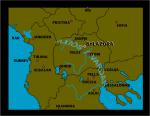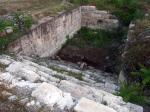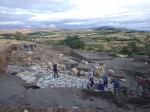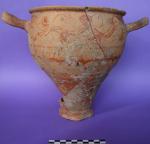Summary (English)
The archaeological site Gradište is located 500 metres to the east of the village of Knežje, in the vicinity if the town Sveti Nikole. After a survey in 1976, Ivan Mikulčić suggested that this is the location of the largest Paionian city Bylazora. Sporadic test trenches in the 1980s and 1990s gave hope that the site might in fact prove to be Bylazora. In the past Bylazora was traditionally associated with the city of (Titov) Veles, based upon a dubious etymological connection.
A subterranean stone-lined chamber approached by a wide stone staircase was the most intriguing structure partially uncovered in the 1980s. It has been called variously a tomb, a pool, a fortified reservoir, and a ritual bath. In 2008, after draining the water and digging out the mud, it was cleared down to the last (22nd) step with the hope of doing a series of trenches to determine the nature of the structure. Unfortunately, on the night of July 3, a torrential downpour filled the structure once more with mud and water. Further excavation will have to be conducted only after the structure is adequately protected from rain and mudslides.
Most of the efforts in the 2008 season were concentrated in Sector 3 on the acropolis. During the first days of the excavation season, a sizeable section of a thick (1.5 meter wide) stone wall was cleared. This may be part of the northern defensive wall of the acropolis. Building remains and pottery from an earlier habitation were uncovered to the north of this wall. Unfortunately, the July rains prevented any further clearance of this stratum.
Perhaps the most interesting feature uncovered in the 2008 season was a steep inclined stone ramp, about 4 meters wide, leading up from the wall to a well-built threshold. The threshold has a square socket hole in it which indicates the ability to securely bolt the gate of whatever structure lies behind the threshold. From the abundance of roof tiles discovered on the ramp, it appears that this was a roofed structure. At the base of the ramp, where it intersects the wall, a mass of ash, charcoal and charred animal bones was found. This suggests that the ramp might lead to a temple or to a large civic building.
Evidence from the excavations alongside the ramp and the defensive wall suggests that this section of the city was destroyed in the 4th century BC. After the destruction, squatters moved into the ruins, leaving behind simple hearths and heaps of pottery, but little in the way of substantial architectural remains. On the last days of the 2008 dig, the excavations beneath this squatter level revealed two large walls which are connected with the defensive wall.
Director
- William Neidinger - Texas Foundation for Archaeological and Historical Research
Team
- Boban Husenovski - Museum of Gevgelia
- Stefan Danev - Museum of Sveti Nikole
- Eulah Matthews - Texas Foundation for Archaeological and Historical Research
Research Body
- Museum of Sveti Nikole
Funding Body
- Texas Foundation of Archaeological and Historical Research






![Download [PDF]](/excavation/skins/fasti/images/results/download_sml.png)


